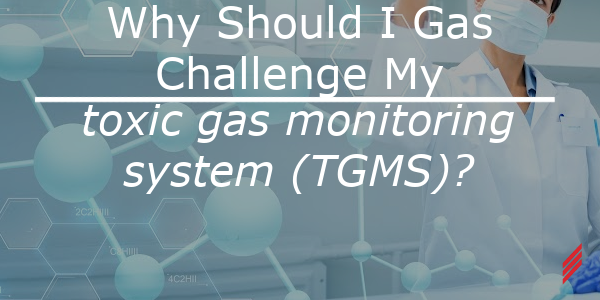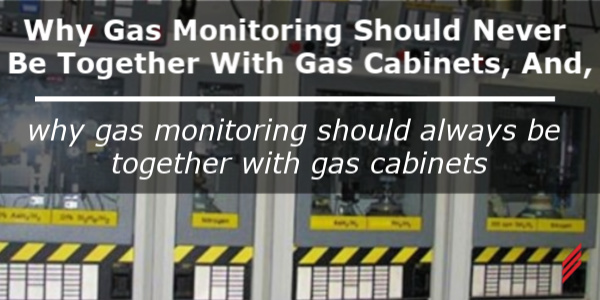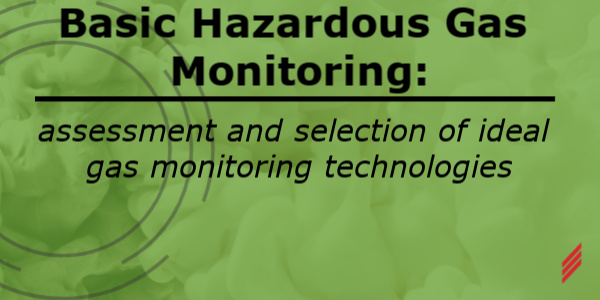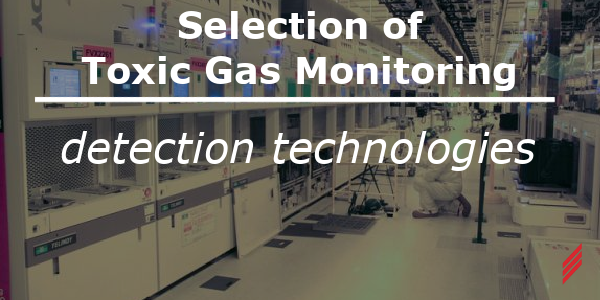Why Should I Gas Challenge My Toxic Gas Monitoring System (TGMS)?
by Vin Calio on Jan 5, 2023 10:30:00 AM

As someone who works with hazardous gases on a regular basis, you know that gas detection is important for both safety and compliance. But what happens when the gas monitoring system itself becomes a hazard? In this blog post, we'll explore why gas challenging a toxic gas monitoring system (TGMS) is sometimes necessary - and how to do it safely.
What is gas challenging and why is it necessary?
Gas challenging, also known as bump testing, is a process used to test the accuracy and sensitivity of a TGMS. It involves exposing the system to a known concentration of test gas in order to verify that the system is able to accurately detect and measure the gas.
There are several reasons why gas challenging is important:
- It helps to ensure that the gas monitoring system is functioning properly and is able to accurately detect the presence of toxic gases.
- It allows users to verify that the system is sensitive enough to detect low levels of toxic gases, which is important for ensuring the safety of workers who may be exposed to these gases.
- It helps to identify any issues or problems with the gas monitoring system, such as faulty sensors or incorrect calibration, so that they can be addressed and corrected.
Overall, gas challenging is an important part of maintaining and verifying the effectiveness of a TGMS. It helps to ensure that these systems are able to accurately detect and measure toxic gases, which is essential for the safety of workers and the public.
How to challenge a gas monitoring system?
There are several steps involved in gas challenging a TGMS:
- Prepare the test area: Make sure that the test area is well ventilated and that any personnel in the area are wearing appropriate personal protective equipment (PPE).
- Select a gas challenge agent (test gas): Choose a gas challenge agent that is appropriate for the type of detector being tested, and according to manufacturer's recommendations. This may be a gas cylinder or a gas generator that produces a known concentration of test gas.
- Perform a flow test to ensure the integrity of the sample tube from the sample point to the detector.
- Check any internal and external filters in the detector or sample tube and replace as necessary.
- Expose the gas monitoring system to the gas challenge agent: Turn on the gas challenge agent and expose the gas monitoring system to the gas for a specified period of time.
- Record the results: Record the readings from the TGMS and compare them to the known concentration of the gas challenge agent. If the readings are within the acceptable range, the system has passed the bump test. If the readings are outside the acceptable range, the system may need to be calibrated or repaired. Examples of data that is collected include: Response time, Concentration, Sample Flow Rate, and Time to Alarm.
- Document the results: Document the results of the bump test and any necessary repairs or calibrations.
It's important to follow proper safety procedures when bump testing a TGMS, as some gases can be harmful or even lethal if inhaled. Make sure to follow all manufacturer's instructions and any applicable regulations when performing a bump test.
What are the benefits of gas challenging?
There are several benefits to bump testing a TGMS:
- Ensures accuracy: Gas challenging helps to ensure that the gas monitoring system able to detect and measure toxic gases accurately. This is important for the safety of workers and the public, as an inaccurate gas monitoring system may not provide adequate warning of the presence of toxic gases.
- Identifies problems: Gas challenging can help to identify any problems or issues with the gas monitoring system, such as faulty sensors or incorrect calibration. This allows users to address and correct these issues, ensuring that the system is functioning properly.
- Verifies sensitivity: Gas challenging allows users to verify that the gas monitoring system is sensitive enough to detect low levels of toxic gases. This is important for ensuring the safety of workers who may be exposed to these gases.
- Meets regulatory requirements: Many industries and organizations have regulations or guidelines that require regular Gas challenging of gas monitoring systems. Bump testing helps to ensure that these systems are compliant with these regulations.
Overall, gas challenging is an important part of maintaining and verifying the effectiveness of TGMS. It helps to ensure that these systems are accurate, sensitive, and functioning properly, which is essential for the safety of workers and the public.
When to call in a professional for help with gas challenging.
There are several situations in which it may be appropriate to call in a professional for help with gas challenging or bump testing:
- If you are not familiar with the process: Gas challenging can be complex and may require specialized equipment or knowledge. If you are not familiar with the process or do not have the necessary equipment, it may be advisable to call in a professional.
- If you are unsure about the safety procedures: Some gases can be harmful or even lethal if inhaled. If you are not familiar with the safety procedures for handling these gases, it may be advisable to call in a professional who is trained in handling hazardous materials.
- If you are having problems with the TGMS: If you are experiencing problems with the TGMS, such as incorrect readings or malfunctioning sensors, a professional may be able to diagnose and correct the issue.
- If you are required to meet regulatory requirements: Many industries and organizations have regulations or guidelines that require regular bump testing of gas monitoring systems. If you are required to meet these regulations and are unsure about how to do so, it may be advisable to call in a professional who is familiar with the regulations and can help ensure that your gas monitoring system is compliant.
 Overall, if you are not comfortable or familiar with the process of gas challenging, or if you are having problems with your gas monitoring system, it may be advisable to call in a professional for help.
Overall, if you are not comfortable or familiar with the process of gas challenging, or if you are having problems with your gas monitoring system, it may be advisable to call in a professional for help.
Hallam-ICS has trained technicians and engineers who can assist you with all aspects of maintaining a Toxic Gas Monitoring System. Please don't hesitate to contact me via email at vcalio@hallam-ics.com with any questions you might have.
About the author
Vin Calio is the Regional Manager, South New England. He is an Electrical Engineer with over 15 years of experience in automation and control systems.
Read My Hallam Story
About Hallam-ICS
Hallam-ICS is an engineering and automation company that designs MEP systems for facilities and plants, engineers control and automation solutions, and ensures safety and regulatory compliance through arc flash studies, commissioning, and validation. Our offices are located in Massachusetts, Connecticut, New York, Vermont and North Carolina and our projects take us world-wide.
You May Also Like
These Related Stories

Why Gas Monitoring Should Never Be Together with Gas Cabinets, And, Why Gas Monitoring Should Always Be Together with Gas Cabinets

Basic Hazardous Gas Monitoring: Assessment and Selection of Ideal Gas Monitoring Technologies



No Comments Yet
Let us know what you think